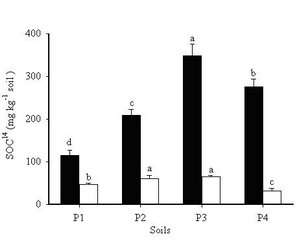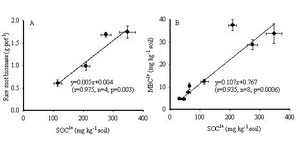Soil organic carbon (SOC) sequestration provides a potential sink for atmospheric CO
2. However, the amount and fate of rice-photosynthesized C entering soil, especially through root exudation, remain unclear. Resolving these issues requires a better understanding of plant-soil interactions in flooded rice-soil ecosystems.
Hence, researchers from the Institute of Subtropical Agriculture, Chinese Academy of Sciences (ISA) selected four paddy soils under permanently flooded rice cultivation incubated for 80 days in a closed, continuously labeled
14C-CO
2 atmosphere to better understand C dynamics in the
soil-plant-microbial ecosystem and investigate the influence of rice-photosynthesized C inputs on the mineralization of the native SOC pool after rice harvest.
After continuous labeling for 80 days, they found greater amounts of C
14 in soil organic C (SOC
14) (114.3 to 348.2 mg C kg
-1), accounting for 0.73%~1.99% of total SOC in rice planted soil compared to the mean SOC
14 concentrations in unplanted soils (31.9~64.6 mg kg
-1) . Namely, the mean SOC
14 concentrations in unplanted soils were 4 times lower than in rice-planted (Fig 1). Meanwhile, the soils SOC
14 concentration in all tested soils was positively correlated with the MBC
14 concentration and rice root biomass (Fig 2). And rice growth promotes more photosynthesized C into soil C pools, which reflects the release of root exudates from rice roots.
"We demonstrate the significance of rice phototrophic fixation of atmospheric CO
2 in the synthesis of organic matter in Chinese paddy soils." said the lead author of the thesis and main researcher GE Tida in ISA.
But he also mentioned that less native SOC mineralization (i.e. a negative priming effect) was found in some soils under laboratory conditions and if this negative priming effect of the new C on native SOC had occurred in the field in the longer term, more C is likely to be sequestered in paddy soils.
ISA researchers’ findings offer vital information on the input, distribution and fate of photosynthesized carbon (C) in plant-soil systems to better understand the nutrient and C dynamics in paddy soils.
This new findings titled “Biological carbon assimilation and dynamics in a flooded rice–soil system” have been published online on Soil Biology & Biochemistry(IF=3.242)on JAN, 26, 2012.(48, 39-46).
Their study was finically supported by the National Natural Science Foundation of China (40901124;41090283), the ‘Strategic Priority Research Program – Climate Change: Carbon Budget and Related Issues’ of the Chinese Academy of Sciences (XDA05050505),the Knowledge Innovation Program of the Chinese Academy of Sciences (ISACX-LYQY-QN-1103), the CAS/SAFEA International Partnership Program for Creative Research Teams (KZCX2-YW-T07; 20100491005-8).
|

|
| Fig.1 The amounts of SOC14to SOC from rice- and non-planted paddy soils during 80-d continuous C14-labelling incubation. |
|

|
| Fig.2 Relationship between SOC14and rice root biomass; SOC14and MBC14from four r paddy soils. |